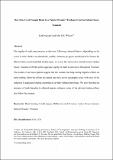How does credit supply react to a natural disaster? Evidence from the Indian Ocean Tsunami
Abstract
The supply of credit may increase or decrease following a natural disaster, depending on the extent to which banks can absorb risk, and the economic prospects and demand for finance by affected firms and households. In this paper, we assess the impact of a natural disaster (Indian Ocean Tsunami of 2004) on the aggregate supply of credit to provinces throughout Thailand. The results of our investigation suggest that the tsunami has long-lasting negative effects on bank lending, albeit the effects are spread unevenly across geographic areas with most of the reduction in aggregate lending occurring in severely affected provinces. We also find that the presence of bank branches in affected regions mitigates some of the adverse lending effects that follow the tsunami.
Citation
Nguyen , L & Wilson , J O S 2020 , ' How does credit supply react to a natural disaster? Evidence from the Indian Ocean Tsunami ' , European Journal of Finance , vol. 26 , no. 7-8 , pp. 802-819 . https://doi.org/10.1080/1351847X.2018.1562952
Publication
European Journal of Finance
Status
Peer reviewed
ISSN
1351-847XType
Journal article
Collections
Items in the St Andrews Research Repository are protected by copyright, with all rights reserved, unless otherwise indicated.

